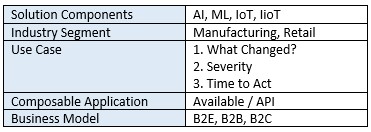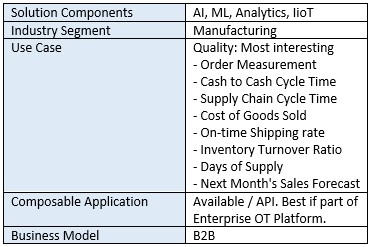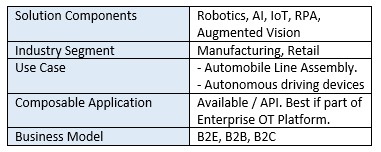
By popular demand, In today’s episode, we will discuss common digital transformation use cases related to Business Operations. Click on Subscribe if you want to be informed of new episodes.
Many of these use cases can be deployed via Composable Applications/API or as part of an Enterprise IT (OT) Platform.
9 Operations Use Cases
Use Case 1: Robotic Process Automation (RPA)
Digitize your processes in weeks without replacing legacy systems, which can take years. Bots can operate on legacy systems learning from your personnel’s instructions and actions. Increase your efficiency and profitability ratios: increase speed, precision, and more.

Implementing RPA solutions requires effort. Suitable processes need to be identified. If a rules-based robot is used, the robot needs to be programmed. Employees’ questions need to be answered. That is why most companies get some level of external help. Generally, outsourcing companies, consultants, and IT integrators are happy to provide temporary labor to undertake this effort.
Use Case 2: Process Data Mining

Leverage AI algorithms to mine your processes and understand your actual processes in detail. Process mining can provide the fastest time to insights about your as-is processes, as demonstrated in case studies.
Use Case 3: Predictive Maintenance

Predictively maintain your robots and other machinery to minimize disruptions to operations. Implement big data analytics to estimate the factors likely to impact your future cash flow. Optimize PP&E spending by gaining insight regarding the possible aspects. (More in Episode 21)
Use Case 4: Manufacturing Analytics

Also called industrial analytics systems. These systems allow you to analyze your manufacturing process from production to logistics to save time, reduce cost, and increase efficiency. Keep your industry effectiveness at optimal levels. (More in Episode 20)
Use Case 5: Inventory and Supply Chain Optimization

Leverage machine learning to take your inventory& supply chain optimization to the next level. See the possible scenarios in different customer demands. Reduce your stock, keep spending, and maximize your inventory turnover ratios. Increase your impact factor in the value chain. (more in Episode 4)
Use Case 6: Robotics

Factory floors are changing with programmable collaborative bots working next to employees to take over more repetitive tasks. Automate physical processes such as manufacturing or logistics with the help of advanced robotics. Increased your connected systems by centralizing the whole manufacturing process. Lower your exposure to human errors. (more in Episode 12)
Use Case 7: Collaborative Robotics

Cobots provide a flexible method of automation. Cobots are flexible robots that learn by mimicking human workers’ behavior.
Use Case 8: Cashier-less Checkout

Self-checkout systems have many names. They are called cashier-less, cashier-free, or automated checkout systems. They allow retail companies to serve customers in their physical stores without needing cashiers. Technologies enabling users to scan and pay for their products have been used for almost a decade, and those systems did not require significant advances in AI. However, these days we are witnessing systems powered by advanced sensors and AI to identify purchased merchandise and charge customers automatically.
Use Case 9: Invoicing

Invoicing is a highly repetitive process that many companies perform manually. This causes human errors in invoicing and high costs in terms of time, especially when a high volume of documents needs to be processed. Thus, companies can handle these repetitive tasks with AI, automate invoicing procedures, and save significant time while reducing invoicing errors.
Good enough?

What are your thoughts on the subjects raised in this edition of the Digital Acceleration Newsletter?
There are many other categories with valid use cases to discuss. We will discuss those in future episodes.
I hope you find them valuable and pertinent. Your feedback is appreciated.
Share them in the comments below, and if you have ideas about other topics you’d like to see covered in this newsletter, feel free to add those suggestions.
